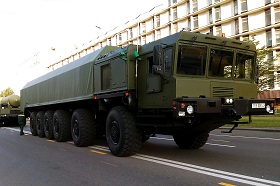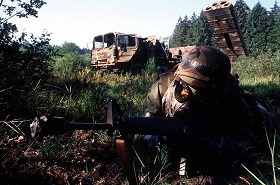Both Russia and the U.S. claim to be committed to the INF Treaty, still the accuse each other of its violation. Will Russia benefit if it decides to withdraw from the Treaty that 30 years ago helped ease tensions between the West and the East and paved a way to new agreements on disarmament?
New missile testing fully corresponds with Russia’s interest. “Forbidden” missiles add on to Russia’s conception of NATO deterrence, limiting Organization’s military activity in Central and Eastern Europe. If Russia withdraws from the INF Treaty, nothing will stop the U.S. from developing and deploying new intermediate-range missiles in Europe. In order to maintain the parity of the intermediate-range forces with the USA, Russia will have to increase significantly its military expenses.
Withdrawal from the INF Treaty or its secret violation will bring us to a situation similar to that of 1983, back to the Cold war with the international situation being extremely tense.
March of 2017 was notable for a severe criticism thrown by the US administration accusing Russia of violating the INF Treaty provisions. Paul Selva, the Vice Chairman of the Joint Chiefs of Staff, claimed that Russia had started deploying ground-based cruise missiles posing a direct threat to NATO’s infrastructure in Europe and having technical characteristics inconsistent with the terms of the INF Treaty. John Hyten, the head of the U.S. Strategic Command, supported this statement when he addressed the Congress on April 4th.
Historical Aspects
The INF Treaty was signed by M. Gorbachev and R. Reagan in Washington D.C in 1987 and banned development, production, testing and deployment of all types of ground-based missiles that could travel between 500 and 5,500 km. The Treaty was a result of many years of scrupulous negotiations intended to end the crisis of intermediate-range missiles in Europe. The crisis erupted in 1976 when the USSR, having no other option but to react to the strengthening of the U.S. forward-based system in Europe, started deploying new and more perfect missiles of intermediate range SS-20 “Pioneer”. This, in its turn, provoked an aggressive reaction in the West, with the U.S.A. deploying its own missiles, the “Pershing II” and “Tomahawk”, in Europe. Years of fruitless talks led to a diplomatic impasse that was finally de-blocked during M. Gorbachev’s era, resulting in the signing of the INF Treaty, which Russia is alledgedly currently violating.
Accusations
Paul Selva’s statement was not the first attempt to accuse Russia of breaking its commitments regarding the INF Treaty. The U.S.A. started blaming the Russian Federation for testing a new missile violating the Treaty’s provisions in 2008, with missile SSC-X-8 (9М729) being the main target of criticism. Americans believe that this missile has technical characteristics similar to those of land attack cruise missiles SS-N-27 Sizzler (Kalibr) with a range of about 2,000 km. If this is true, SSC-X-8 (in case it is a ground-based missile) confronts the terms of the Treaty.
For the time being, there is no official data concerning SSC-X-8; thus, now it is quite impossible to say for sure whether the accusations are true.
Meanwhile, there also has been allegations connected with R-500 ground-based missile (9M728) having a range of 500 km. Currently, those missiles are deployed with some modifications of the short-range ballistic missile system, Iskander. The American party considered these missiles able to travel for a longer distance. However, recently there have been no statements concerning this type of missile.
Finally, the third creation of the Russian military industry that disturbs the U.S.A. is the MIRV-equipped intercontinental ballistic missile SS-X-31 (RS-26 “Rubezh”). Its official range equals about 6,000 km, while the missile is also capable of hitting a target at a distance of 2,000 km. This targeting capability has US officers worried that this missile also violates the INF Treaty.
To sum up, the United States of America had been persistently suspicious of Russia because of the development and tests of three types of ground-based missiles: SSC-X-8 (9M729), R-500 (9M728) and SS-X-31 (RS-26 “Rubezh”). Nevertheless, it was the deployment of 9M729 that turned out to be the turning point that has led to the first official accusation of Russia breaking the INF Treaty ever.
Prove it!
Russia’s official stance regarding the accusations is that the provisions of the INF Treaty are being observed and that the U.S.A. should provide evidence to prove their allegations.
Meanwhile, Russia has its own grounds for suspecting the U.S.A. of breaking the INF Treaty. In May, 2016 the Russian Foreign Ministry claimed that the American launchers Mk-41 deployed in Romania and officially designated for SM-3 intercepting missiles may also be used to launch other types of missiles including a cruise missile “Tomahawk”. Therefore, Mk-41 is considered to be a potential launcher for the ground-based cruise missiles banned by the 1987 Treaty. Obviously, the two parties have mutual claims, both denying the violation of the Treaty and continuing to play “diplomatic ping-pong”.
Do we need the INF Treaty?
Will Russia benefit if it decides to withdraw from the Treaty that 30 years ago helped ease tensions between the West and the East and showed a path to new agreements on disarmament? The answer requires the analysis of possible profits and drawbacks of such a decision, including the reaction of the U.S.A. and its allies.
Pros
The post-war period of the twentieth century proved that the nuclear weapon constitutes a safeguard of international security preventing local conflicts from escalating to a global war. This means that the modernization of the nuclear arsenal should be of a great importance in the 21st century.
In this case, the development of new types of missiles (9M728, 9M729, RS-26 “Rubezh” and others) seems to accord with Russia’s interests. Moreover, hypothetically dangerous NATO-held regions that pose a threat to Russian security have moved closer to its borders over the last 30 years. These new missile defense systems deployed around Russia are, officially meant to restrain Iran and North Korea. These actions necessitate that the Russian Federation take effective adequate measures, including the development of new types of weapons able to withstand NATO.
In reality, the modern world is witnessing the transformation of the post-war system of international relations, with its main pillars being destroyed and new ones being erected. In this sense, the INF Treaty may no longer be necessary or relevant.
Cons
No matter how reasonable the abolition of the INF Treaty might seem, it may lead to some negative consequences.
First, it is unlikely that the U.S.A. will stay committed to the Treaty if Russia quits it. In this case, there will be no bars for the U.S.A. from developing and deploying new intermediate-range missiles in Europe. As a result, we will find ourselves in a situation similar to that of 1983, when the need for the INF Treaty emerged.
Second, it may negatively affect the economy. This is because in order to maintain the parity of the intermediate-range forces with the U.S., Russia has to increase significantly its military expenses. The question is simply whether the Russian economy can sustain it.
Third, it is important to take into account the international reaction. European leaders will most likely not welcome the beginning of a new arms race taking place on their territory. The prospect of being again a part of the Russia–U.S. confrontation will completely ruin the already damaged Russia–EU relations.
And so…
The Foreign Policy Concept of the Russian Federation issued in 2016 differs from its previous versions in that it does not mention the INF Treaty at all, possibly hinting at the Government’s real stance. At the same time, this, as well as the anti-INF claims of some Russian officials, could simply be a game of diplomacy. On the whole, whatever the real attitude of both sides is, we should admit that the intensifying discourse concerning its points occurring simultaneously with progressive deterioration of the post-war system of international relations indicates a pressing need for the construction of a new international architecture.








